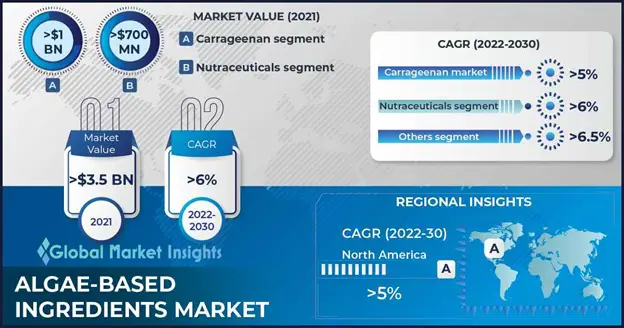The global algae-based ingredients market is set to register a significant expansion from 2022 to 2030, owing to the increasing prevalence of several chronic health conditions and the subsequent demand for nutraceuticals and other nutritional supplements. Unhealthy dietary habits and sedentary lifestyle lead to improper nutrition in children and adults, resulting in an increased risk of heart diseases, obesity, type 2 diabetes, certain cancers, and other chronic diseases.
According to the 2022 report from World Health Organization, cardiovascular diseases cause almost 17.9 million deaths annually. The other health conditions such as cancers, chronic respiratory diseases, and diabetes lead to 9.3 million, 4.1 million, and 2 million mortalities in a year, respectively. The increasing disease burden, in covalence with the rising health concerns, and surge in expenditure on nutritional products may stimulate the demand for algae-based ingredients over the projection period.
The agar segment exceeded USD 220 million in 2021 and is expected to expand at over 4.5% CAGR between 2022 and 2030. The gel-like substance found in agar causes a bulking effect in the gut that stimulates the intestines and creates a bowel movement, making it useful as a laxative. The increasing utilization of the product as a weight loss ingredient due to its tendency to make people feel full and enabling appetite control will promote the agar segment growth in the forthcoming years.
The algae-based ingredients market share from the brown algae source segment accounted for over USD 630 million in 2021 and is expected to depict over 5% CAGR during the assessment timeframe. Brown algae are found to beneficial for several health conditions, such as cancer, arthritis, fibromyalgia, stress, weight loss, high cholesterol, heart disease, and others. The antioxidant effects of the product facilitate oxygen supply to the skin, prevents the degradation of collagen, and support healthy cell growth, supporting usage of brown algae in personal care products.
The pharmaceutical segment is poised to record a valuation worth over USD 370 million by 2030, exhibiting a noticeable growth rate throughout the forecast period. The increasing number of pharmaceutical companies are incorporating algae-based oils and proteins in the production of several drugs. In addition, the extensive utilization of microalgae in producing bioactive compounds, including enzymes, hormones, and monoclonal antibodies in several therapeutic applications may further bolster product demand.
The Latin America algae-based ingredients market is anticipated to record a sizeable valuation, depicting a CAGR of over 6% between 2022 and 2030. The presence of favorable trade and FDI policies has streamlined the expansion of pharmaceuticals and F&B industries, creating new growth prospects for the regional market. Besides, the emerging health and beauty trends, and the subsequent rise in the consumption of nutraceutical and nutricosmetic products will drive the demand for algae-based ingredients across Latin America.
Source https://www.gminsights.com/industry-analysis/algae-based-ingredients-market







